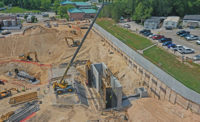Low oil and gas prices are continuing to restrict the petroleum industry’s development of exploration and production infrastructure, but the need to deliver affordable liquefied natural gas (LNG) and other fuels to economic centers will boost prospects for pipeline and other distribution infrastructure investments in Asia and other regions. Energy-rich Russia, for instance, is seeking to develop numerous pipelines into Asia and other areas.
Firms working in the sector anticipate a robust market for engineering and construction services. Of the petroleum-sector representatives surveyed as part of a Black & Veatch report, published in October, on the natural-gas industry, nearly 70% characterized themselves as “optimistic” or “very optimistic” about future growth in the global oil-and-gas industry.
|
Click Here to View ENR's 2016 Global Sourcebook |
China and Japan stand out as “highly sought-after” examples of energy demand centers, says Bob McDonough, vice president with Hill International. As a result, “you’re going to see a continued increase in pipelines,” McDonough says. “There’s just the need to get product from Point A to Point B.”
On Oct. 10, Russia and Turkey inked a deal to build the TurkStream pipeline, which will deliver natural gas across the Black Sea bed, from Turkey to European countries. Estimated at more than $12 billion, the pipeline will run 660 kilometers along the route of the canceled South Stream project and 250 km along a new route, toward the European part of Turkey, the company says.
Also, Canadian petroleum engineering company Genoil Inc. on Nov. 9 announced it had signed a $50-billion letter of intent to develop oil fields, refineries and pipelines in Russia, with the fuel produced slated to be exported to China. According to Genoil, Chinese banks will provide full financing to the Russian firms participating in the project. “Russia’s certainly trying to do a supply push out of its production regions, bringing gas into Europe as well as Asia,” says Deepa Poduval, senior managing director with Black & Veatch.
The natural gas will flow mostly to non-OECD countries—that is, nations that are not members of the Organisation for Economic Co-operation and Development. They are generally forecast to experience higher economic growth rates. “Non-OECD Asia is considered the hub of the next level of consumption growth, as well as where a lot of infrastructure development activity will occur,” Poduval adds. “That’s definitely where the action is.” China, Russia and India are all non-OECD countries.
“Iran will likely enter the market as another supplier now that the sanctions against them have been lifted,” Poduval adds, noting that the country has ambitions to serve neighboring Persian Gulf nations as well as India and Pakistan.
As Mexico denationalizes Pemex, its oil company, “a lot of pipeline companies are running pipe from the U.S. into Mexico,” adds McDonough. Further, he speculates that Donald Trump’s election as president may benefit pipeline developers in the U.S.
In Canada, Prime Minister Trudeau on Nov. 29 said he had approved two new pipeline projects: Kinder Morgan’s TransMountain pipeline and Enbridge’s Line 3. He rejected a third project, running from Alberta to British Columbia (see related story, p. 10).
Export facilities and import terminal projects also will provide contracting opportunities for petroleum-sector engineering and construction firms, according to the Black & Veatch report. “Increased LNG imports can help address worldwide natural gas oversupply,” it notes.
Floating LNG (FLNG) facilities are another emerging technology that should improve worldwide distribution. In October, Black & Veatch announced that its design of a FLNG unit, for ExMar, successfully completed performance testing in China. ExMar’s Caribbean FLNG facility will be located off the coast of Colombia.




Post a comment to this article
Report Abusive Comment